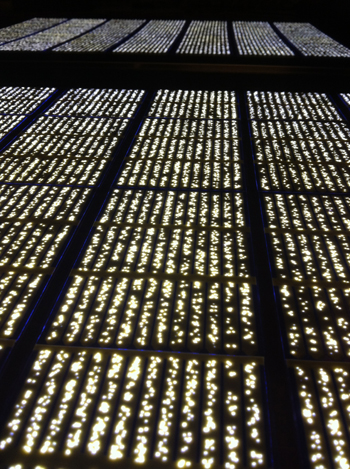Nth Degree Makes Flat, Flexible, Printed LED Lights
I’m starting to worry that I’m turning into an ostrich.
I’m territorial and ill-tempered. I’m fighting a strange desire to eat shiny objects. And when I get scared, I find myself hiding my face as though not seeing whatever is scaring me will make it go away. And this may or may not be related: I’m developing a strong aversion to light bulbs.
Image courtesy http://www.ostrichheadinsand.com/
A company called Nth Degree Tech may be able to help me out with that last problem. They’re seeking to replace light bulbs with their first commercial product, a two foot by four foot LED light sheet that’s flat and looks like a glowing piece of paper, which they plan to ship to customers for evaluation by the end of the year (Bullis). This is an exciting development, since it would allow lighting designers to get freaky with curved or unusually shaped light-emitting surfaces – at a price point comparable to the current cost of fluorescent light bulbs and fixtures.
Image courtesy Nth Degree Tech
To make their snazzy new lighting material, Nth Degree workers carve up “a wafer of gallium nitride to produce millions of tiny LEDs—one four-inch wafer yields about eight million of them. The LEDs are then mixed with resin and binders, and a standard screen printer is used to deposit the resulting ‘ink’ over a large surface” (Bullis). They toss down a layer of silver ink for the back electrical contact, add a layer of phosphors that alter the color of the light emitted by the LEDs from blue to various shades of white, and then they slap on an insulating layer that prevents those pesky short circuits that can burn out the LEDs.
The front electrical contact is made with an ink containing invisibly small metal wires, which makes it transparent and allows light through the layer. The transparent electrical contact ALONE could be the subject of an entire article, since it’s unspeakably awesome. Its awesomeness derives from the fact that it may eventually replace the brittle and often testy indium tin oxide (ITO) sheets that have been used in touch screens and electroluminescent assemblies in the past. ITO can be expensive, it can’t be printed and it’s not at all flexible – it deserves to be made redundant.
Image courtesy Nth Degree Tech
While printing with inks that are comprised of “tiny working LEDs produces much brighter light than depositing powders or thin films of electroluminescent material,” Nth Degree’s light sheets don’t match the best LEDs available today, which emit over 200 Lumens per watt. The sheets are better than incandescent lights in terms of efficiency, emitting 20 lumens per watt, but they’re not as good as fluorescent lights just yet, which emit 80 lumens per watt (Bullis).
The new design won’t require heat sinks the way current conventional LEDs do because the lights are distributed evenly and in a thin layer, meaning that they do not get hot. The downside is that the tiny LEDs need a pretty robust power source and as a result, Nth Degree’s first light fixture will be two inches thick despite the fact that the light-emitting surface is thin and flexible (Bullis). I’m not letting that ruffle my feathers, however, since I’m betting that the whole assembly will get thinner over time.
Filed under FIRE because it lights up!
Cited:
Bullis, Kevin. “Lighting Sheets Made of Tiny LEDs” Technology Review Online. 10/28/11. Accessed 02/24/12. URL.


















The first product is a 2ft by 4ft light panel that will replace a four tube fluorescent fixture. The power supply is a little under two inches thick because: (1)code requirements and (2)it is powering 5000 effective lumens. The entire panel, including the power supply, is under 2 inches thick and weight 11.3 lbs.
A 200 lumen/watt LED requires a heat sink the size of a can of soup and they are expensive.
And awesome is what the first beta customer said about the ITO replacement ink.
The Nth team appreciates your comments
Interesting! I don’t know much about this ink but seem it’s very interesting to apply. But being an ostrich is sounding very concerning and I think you should leave it initially to avoid the long term depression. Good luck for you.
http://www.justuno.com/
Leave a Wordpress Comment:
Ads
Watch ARCHITERIALS Videos on vimeo
Like on Facebook
Twitter
Flickr
Hit Counter
Ads
Blogs
Green
Journals/Publications
Materials
Network/News
Offices/People
Resources
Science
Pages
Archive
RSS and Email Subscriptions
Tag Cloud
3D 3D printer AB FAB academic acid acrylic actuated matter adaptive adhesive adsorption aerogel air air conditioning alloy aluminum amnh antibacterial antifungal ants april fool's architecture architecture robot artificial skin autonomous aviation awesome bacteria bamboo bananas beer bench bend bending biennale biocomputing biodegradable biodegradeable biomaterials biomimetics biomimicry biominerals biopolymer birds blast blast-resistant block blocks blogs Bloom Box brazil brick bubbles bucky bulk metallic glass butterfly calera canvas carbon carbon fiber carbon nanotubes carpet cars ceiling cellulose cement ceramic chain link chair charcoal charlie sheen chemicals chiller clay cloth cloud cmu coils color color-changing communication compound computer concrete condensation conducting conductive context cool coral cracks crystal cyborg demakersvan design digifab dirt disaster dna dror drywall dutch dynamic EAP earth ecocradle ecolect e coli ecology ecoresin ecovative elastic electric electricity electrochromic electroluminescent electronic energy energy recovery environment evaporative cooling experiment fabric fabrication facade fiber fiberglass fiber optic fiber optics fibers film FIRE flexible flickr fly ash foam fungus furniture garbage gel geodesic dome geometry gfrp gilgamesh glass glass fiber glow glue gold graphene green greensulate gsapp gypsum hard heat heavy heidi klum helix hemp hexagon hidden high performance hive honeybee humidity ice India ink insulation interference Internet inventables invisible invisible ink jello jellyfish just add water kevlar kinetic korea lace lamboo laser lattice leaves LED leed LEGO light light emitting light transmitting liquid lo mein london Loop.pH machines magic magnetic marine material materials meatball melting memory metabolic engineering METAL metal panel metamaterial micro microsensor microtools military milk MIT moisture multi-layer mushrooms mycelium nano nanogel nanotech nanotubes NASA new noise non-metallic oil OLED OMA ostrich oysters packaging paint panel panels paper paperfoam paraffin wax particles particulates petroleum phase change phosphorescent pink PLA plastic platinum pm-10 poetry pollution polymer polymers porcelain power precast printed printing protein public quadror radiant rain rammed earth reclaimed recycled reflective refracting Rem Koolhaas resin robot robotics roof rubber rugged sand sealant sealer search segmented self-healing sensor shape memory silica silicon silk skin skittles slats smog soft solar solar cell solar cells solar paint solid solid state lighting sound spider spider glue spray stabilized sand stone stretch stretchable strong structural structure studio dror sun sunglasses super supercritical sustainable switzerland tags tape technology TED tensile TEXAS textile textiles texture thermal thermochromatic thin thin film thread tiger stone tile tiles timber tio2 tires toaster tokujin yoshioka touch touch-sensitive toxic transparent t shirts tulip ultra-thin university of akron university of connecticut upcycling virus voc wall wallpaper WATER web wet whale wires WOOD woodwool wool workshop
WP Cumulus Flash tag cloud by Roy Tanck and Luke Morton requires Flash Player 9 or better.
Recent Comments
Ads